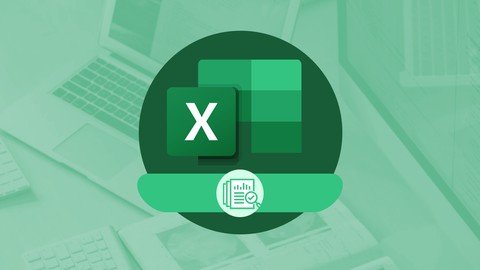
Published 6/2022
MP4 | Video: h264, 1280×720 | Audio: AAC, 44.1 KHz
Language: English | Size: 781.60 MB | Duration: 1h 30m
Learn how to use Excel to analyze, summarize, and visualize your data.
What you’ll learn
Be able to clean up data into well-defined lists and convert them to tables
Use Excel’s aggregate functions to conditionally apply summary calculations to the data
Display data in summarized formats using pivot tables
Summarize data visually using pivot charts
Requirements
Basic knowledge of Excel is recommended
Description
Beyond simple averages and totals, Microsoft Excel offers many features to help you draw insights from your data. Sometimes those observations come from a particular formatting or visualization of the data; other times a specific summary function will generate a surprisingly significant result.Here are some of the techniques you’ll learn:Table Formatting. Cleaning up your data involves tasks like removing duplicates, eliminating empty rows, and making sure data types are correct. Once you have a well-formatted table, you can take advantage of Excel’s many features to sort, filter, and colorize it – revealing hidden patterns.Conditional Functions. You may have data that you want to exclude from your calculations: for example, too-low or too-high outliers, or relating to discontinued products, or months with sales promotions. To exclude this data from your summaries, you can use functions like SUMIF, AVERAGEIF, and COUNTIF – applying them to exclude data that doesn’t meet certain criteria.Charting. Whether it’s a pie chart, line graph, or scatter plot, "a picture is worth a thousand words." It’s critical to choose the right type of chart to visualize your data so the viewer can quickly make sense of it. We’ll show you how to decide which chart works best with your data.Pivot Tables. Many spreadsheets follow a pattern with a few heading fieldsand many rows based on one field, like order number (sales tables) or product SKU (inventory tables). In the case of sales data, a table will typically have column headers like location, quantity, order number, price, and such. Each row might represent one order. Turning a typical table like this into a pivot table allows you to quickly change the way you 1) view the data: orders by date vs. orders by location; and 2) group the data for aggregate functions: total orders by location, average quantity by order, etc. It’s one of Excel’s most powerful tools, and can be used in conjunction with pivot charts to easily visualize your data along different dimensions.
Overview
Section 1: Exercise Files – Download Before Starting the Course
Lecture 1 Exercise Files
Section 2: Course
Lecture 2 Introduction
Lecture 3 Preparing Data for Tables
Lecture 4 Removing Blank Rows and Duplicates
Lecture 5 Using Flash Fill to Apply Table Styles
Lecture 6 Applying Table Styles
Lecture 7 Auto Sorting and Filtering in Tables
Lecture 8 Applying a Custom AutoFilter in Excel Tables
Lecture 9 Adjusting Table Style Formats and Options
Lecture 10 Applying Total Rows
Lecture 11 Adding New Data and Turning Off Table Styles
Lecture 12 Applying Conditional Formats
Lecture 13 Editing and Turning Off Conditional Formats
Lecture 14 IF Functions
Lecture 15 SUMIF Functions
Lecture 16 COUNTIF Functions
Lecture 17 AVERAGEIF Functions
Lecture 18 Creating Charts
Lecture 19 Editing and Reformatting Charts
Lecture 20 Creating Sparklines
Lecture 21 Creating Win-Loss Sparklines
Lecture 22 Creating Pivot Tables Using the Recommended Pivot Tables Button
Lecture 23 Creating Pivot Tables from Scratch
Lecture 24 Editing Summary Function and Format of Pivot Table Value Fields
Lecture 25 Filtering, Sorting, and Editing Pivot Table Fields
Lecture 26 Grouping Column Labels in Pivot Tables
Lecture 27 Creating Slicers
Lecture 28 Refreshing Pivot Table Data
Lecture 29 Creating and Updating Pivot Charts
Lecture 30 Conclusion
This beginner data analysis course is designed for Excel users who need to analyze, summarize and visualize their data. Basic knowledge of Excel is recommended: familiarity with formulas, cell referencing, and simple functions like SUM and AVERAGE.
Homepage
https://www.udemy.com/course/learnit-excel-2019-intro-to-data-analysis/
DOWNLOAD FROM RAPIDGATOR.NET
DOWNLOAD FROM NITROFLARE.COM
DOWNLOAD FROM UPLOADGIG.COM



